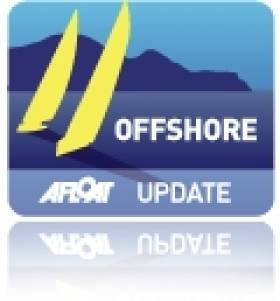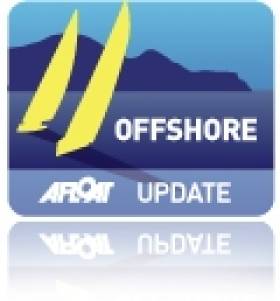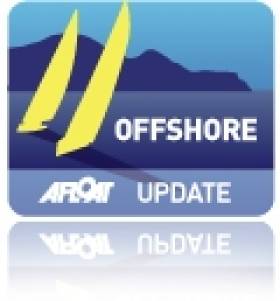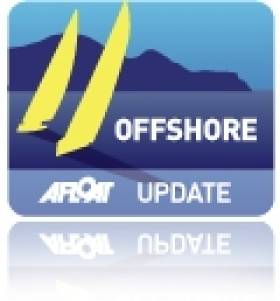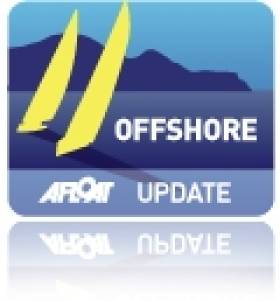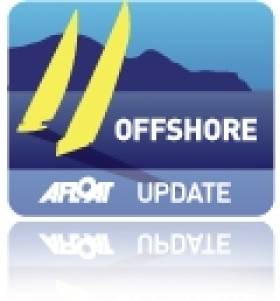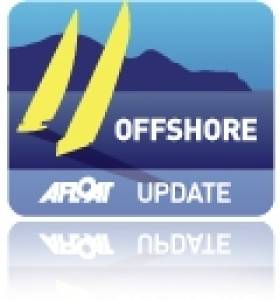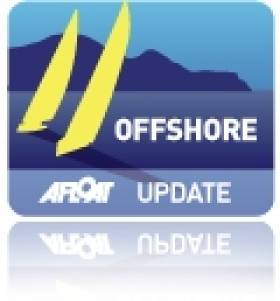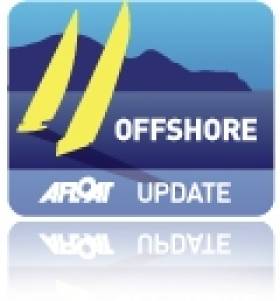Displaying items by tag: Offshore
French Skipper Fined £9,000 for Breaking Navigation Rules
A French skipper has been fined £9,000 for the infringement of navigation rules during his Round Britain and Ireland record attempt in June. Marc Guillemot was charged with breaking navigation rules twice in the Straits of Dover during his attempt to beat his own record.
Following his fine Guillemot issued the following statement:
Today, Thursday 6th December 2012, the British justice system issued its judgement following Marc Guillemot's infringement of navigation rules during his Round Britain and Ireland record attempt in June 2012. The skipper will have to pay a fine of 9 000 £.
Reminder of what happened
On 7th June 2012, Marc Guillemot was charged with breaking navigation rules twice in the Straits of Dover during his attempt to beat his own record. Marc Guillemot and his crew did in fact enter the traffic separation system without respecting the lanes and rules regarding crossing this zone.
On 12th July, Marc Guillemot willingly attended a meeting following a summons from the British coastguards (MCA) to find out exactly what he was being accused of and immediately accepted their version of events.
In early September, he was summoned to a hearing, which was due to take place in Southampton on 2nd October at the Magistrates Court. The sailor, who was busy preparing for the Vendée Globe offered his excuses and was represented by his lawyer, to whom he gave instruction to plead guilty.
The judge did not wish to excuse Marc Guillemot's non-attendance and issued a warrant against the skipper. The validity of the warrant issued by the judge was contested by Marc Guillemot at the high court, which led to it being cancelled, and his summons to appear was put back until after the Vendée Globe.
Marc Guillemot was therefore able to line up at the start of the race on 10th November as planned.
The judgement from 6th December
Following his retiral from the Vendée Globe, Marc Guillemot made himself immediately available to the British authorities and was summoned to a hearing on 6th December at the Magistrates Court in Southampton, which he willingly attended accompanied by his legal advisors.
During the hearing, the judge issued Marc Guillemot with a fine of 9 000 £.
'St Brendan Voyage' Fisherman Finds Fame on Iceland
#VOYAGE - The Irish Independent reports on the rapturous welcome received by retired Irish fisherman Finbarr Murphy in Iceland as he retraces the route of St Brendan the Navigator.
The West Cork sailor has already travelled on his restored yacht, the 19-metre Bella Donna, via the Orkneys, Norway and the Faroe Islands - crossing the freezing waters of the far north Atlantic to reach Iceland last month.
Since his arrival he's been treated as a celebrity, with regular appearances in the press and on TV and radio, and so has understandably decided to spend the rest of the winter in Iceland before the final leg of his voyage to Greenland early in the new year.
Murphy isn't the first to retrace the voyage of the legendary St Brendan, as last year a crew of sailors, artists, musicians and historians attempted the same on board Paddy Barry's 45ft yacht Ar Seachrán.
As previously reported on Afloat.ie, that trip hit a snag along the way in May last year when the boat was refused permission to land on Skellig Michael off the Kerry coast.
ISORA agm to Agree 2013 Offshore Race Programme for the Irish Sea
#isora – ISORA has issued its 2012 AGM Agenda plus its 2013 draft Race Schedule for the Irish Sea next year. Both are available for download below as pdf documents.
The race programme will be approved on November 17th at the National Yacht Club. Unfortunately the date clashes with the one day Irish Cruiser Racer Conference (ICRA) in Kilkenny where offshore supremo Damian Foxall will give a presentation.
The ISORA agm is followed by the Annual ISORA Prize Giving Dinner at the NYC where some of the most elegant sailing trophies including the Wolf's Head Trophy will be presented.
Hurley & Boyle Win Double Handed Middle Sea with Only Minutes to Spare (Podcast Here!)
#middlesearace – There were emotional scenes dockside in Malta this morning as Irish sailors Barry Hurley and Andrew Boyle sailed home in their 35-yacht Dinah to win the double handed class, they finished just 25 minutes inside the time limit after seven days of tense racing in the Rolex Middle Sea Race.
Hurley has described the race as the 'most intense' race he has ever sailed due to the stop start nature of the winds. In an exclusive podcast (below) by Afloat correspondent Louay Habib, Hurley admits there was 'real pressure' over the last few hours. The overall achievement has yet to sink in for the Dun Laoghaire pairing but it has not stopped early celebrations this morning that has made sailing the boat 3000 miles from Dun Laoghaire to Malta a really worthwhile conclusion to the 2012 season.
Only last night the pair were judged as outsiders to finish the race at all such has been the fickle conditions for the 33rd race but a favourable wind overnight allowed Hurely and Boyle to pick up seeds of 17 knots at times to cover 120 miles in 12 hours.
The Mediterranean odyssey ended with an official welcome home from Irish Ambassador Jim Hennessy who was waiting to welcome the Royal Irish Yacht Club boat and celebrate yet another international victory for the offshore sailing champions.
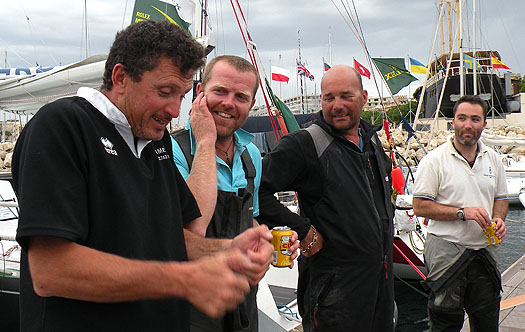
The crew of Dinah and Atame share a beer and a few stories dockside after tying up at The Royal Malta Yacht Club. The two teams had been locked in combat for 7 days and nights. L-R Beppe Bisotto, Barry Hurley, Ian Knight and Andrew Boyle Photo: Royal Malta Yacht Club/Louay Habib
Hennessy who held a pre-race reception for the Irish crews in Malta was also first to congratulate the pair on stepping ashore. 'It's a really gutsy performance that has defied a lot of the experts here in Malta. We're really proud of them, it's a great win, he told Afloat.ie as he held the tricolour aloft with the crew at the Royal Malta Yacht Club.
There was other Irish involvement in the race from Dun Laoghaire yacht Gallileo skippered by Des Keliher. The Beneteau 44.7 yacht retired due to the light winds on Tuesday but there has been Irish interest in at least two other international entries in the 83-boat fleet.
Fireball dinghy champion Kenny Rumball also from Dun Laoghaire was aboard German entry Kohinoor, a Carter 55 Custom Sloop and Irish sea offshore campaigners Liam Coyne and Brian Flahive was racing on the Maltese J122 entry Otra Vez.
As well as Irish boats heading to the Med for racing Ambassador Hennessy says he is keen to create a 'two way movement of boats' and is hopeful that Maltese boats with Irish sailors aboard will head north next year for 'The Gathering'.
Irish Sailors Stay Second in Middle Sea Race after Maltese Thunderstorm
#middlesearace – Dun Laoghaire yacht Dinah sailed by Barry Hurley and Andrew Boyle are maintaining second overall in the double-handed class inspite of a massive thunderstorm and torrential rain engulfing Malta overnight in the latest update from the Rolex Middle Sea Race.
IRL3508, a modified JOD 35-foot yacht is 232 miles from the finish line and expected to be the 66th boat to cross the line in the 83 boat fleet. The experienced offshore pairing were making just over 4 knots in the still tricky conditions as the race enters its closing stages.
Late last night before the thunderstorm struck and engulfed Malta in heavy rain Hurley told Afloat.ie 'We're doing ok in our class although our main competition is now in different weather systems, so we need to work extra hard to keep in contention. Fingers crossed we have what it takes! Hurley told Afloat.ie
Meanwhile, Nick Lazos and Periklis Livas' Farr 52, Optimum 3 Aspida crossed the finish line to lead Class Two and the Rolex Middle Sea Race overall. However, the Greek team's tenure on this extra-ordinary race was very short lived. At 04:18 15 Eddie De Villiers, Welbourne 46, Hi Fidelity crossed the finish line to take the overall lead in the race.
In driving rain with thunderbolts lighting up the medieval bastions, the South African crew, soaked to the skin, looked astonished to find out that they are now the hot favourites to win the overall prize for the Rolex Middle Sea Race.
To put the amazing performance into perspective, Hi Fidelity's corrected time was nearly seven hours quicker than Niklas Zennstrom's JV72 Ran but the team had no idea until they finished.
"We didn't have a clue how well we were doing until we finished, it is unbelievable," exclaimed De Villiers. "The crew have been absolutely fantastic, I can not give them enough praise. This has been one hell of a race, we have had just about everything thrown at us. Coming through the Comino Strait there was a terrific amount of thunder and lightning it was all around us and the wind touched 37 knots. To come through the finish and find out that we have such a great result is truly amazing!"
Two yachts pose the biggest threat to HI Fidelity's overall lead Josef Schultheis' & Paolo Semeraro's Xp44, XP-ACT and the reigning Rolex Middle Sea Race champion, Lee Satariano & Christian Ripard's J/122, Artie RTF. Both yachts are expected to finish this afternoon.
Irish Yachts Negotiate Tricky Strait in Middle Sea Race
#middlesearace – Both Irish entries in the Middle Sea Race are, like the bulk of the fleet, negotiating the Strait of Messina this morning and making only two knots headway off the Sicilian coast. The National Yacht Club's Gallileo, a Beneteau First 47.7 and the double handed Dinah, a JOD 35 are now thirty hours into the contest, all 83 yachts are still racing with the bulk of the fleet dealing with variable winds in the infamous Strait
Des Kelliher from the RIYC is skippering Galileo co-owner Tony Tennyson of the NYC will also be on board along with various crew from this year's ISORA series. Kelliher's club mate Barry Hurley is skippering Dinah.
What has develoed is a tactically challenging and meteorologically intriguing 33rd Rolex Middle Sea Race. Leading the fleet, and midway between the Strait and Stromboli, are the 30.48m/100-ft Esimit Europa 2 (SLO), and two 21.94m/72-ft Mini Maxis Ran 2 (GBR) and Stig (ITA). Currently sailing at a meagre two knots, the three are separated by less than one mile.
Esimit Europa 2 has not broken away from the pack in the manner she has become accustomed to in previous editions. The first night proved frustrating for Igor Simcic's crew, caught in a fading breeze that allowed her rivals to close in. On the approach to the Strait this morning, Ran 2 took advantage of a positive current to close the gap on Esimit, and even take the lead. By midday the two boats were only 100m apart exiting the Strait together, destination Stromboli.
18 yachts have now passed the Strait of Messina. The current advantage on handicap belongs to defending champion - Lee Satariano's J/122 Artie (MLT). It is a precarious lead as the fleet heads into the second evening and a frustrating search for breeze.
Live race tracking from the 33rd Rolex Middle Sea Race is available here as a record-breaking 83 international entries contest this classic offshore race.
Irish Two Handed Entry Ready for Middle Sea Challenge
#middlesearace – The winner of this Summer's inaugural Round Rockall offshore Race is in Malta tonight preparing for Saturday's Middle Sea Race, an event that is preceded for Barry Hurley's Dinah by tomorrow's warm up coastal race.
The Dun Laoghaire two-handed entry, a JOD 35, is ready for the weekend challenge and is one of at least two Irish entries involved.
"I have sailed nearly 3000 miles to get here but this is not my first race, I have competed six times before, often with Maltese boats and I have very fond memories of those races. This year, I had the chance to come here and sail in my own boat and I am really looking forward to a great race.
Hurley is an experienced campaigner. Sailing Dinah, he finished the 2009 OSTAR (singlehanded transatlantic race) in Newport, Rhode Island, USA as a class winner after 21 days at sea.
With less than 5 days to go to the start of the 33rd edition of the Rolex Middle Sea Race, a steady stream of boat captains have been making their way to the Royal Malta Yacht Club making their final registrations for the race. Yachts from 18 different nations are taking up their berths at The Royal Malta Yacht Club and the Grand Harbour Marina. The extensive facilities at the club will be put to good use, as Thursday night's Crew Party, will cater for 1500 invited guests. Racing starts tomorrow (Wednesday 17th October) with a coastal race in preparation for the main event, which starts on Saturday 20th October.
At a packed press conference held on the terrace of The Royal Malta Yacht Club, the Commodore, Godwin Zammit introduced Principle Race Officer, Peter Dimech who explained the planning that has been put in place to start The Rolex Middle Sea Race from the historic Grand Harbour.
"It is too early to establish exactly what the weather will be like on Saturday but there is no doubt that the Grand Harbour will be extremely busy with competing boats. Transport Malta has closed the harbour to other shipping from 0830 until 1300 and we would specifically ask that any vessels that are in Grand Harbour keep well clear of the competing yachts. We are especially grateful to Transport Malta and the Armed Forces of Malta, who have been extremely co-operative, with a record number of yachts expected on the start line, we would anticipate that there will be four or five different starts, probably the best view will be from the Upper Barrakka Garden, I am sure it will be an amazing spectacle."
The press conference was attended by a number of Maltese and overseas skippers taking part in the race.
Lee Satariano, the co-skipper of last year's overall winner, Artie-RTFX:
"I think if anything we are actually better prepared than last year and we have been working hard on our performance and hope we can do ourselves justice but above all we are looking forward to enjoying the race, once again the entire crew is from Malta."
Arthur Podesta, skipper of Elusive 2 has done them all, competing in every race since 1968:
"This race was always designed to be a classic Mediterranean race and that is what it has become, the first race had only 8 boats and it has just got bigger every year. It is a fascinating race, maybe you could say it is six races rather than just one, as the course is so changeable, it always keeps one interested."
Volvo Ocean Race skipper and Olympic sailor, Andreas Hanakamp will be racing on the Austrian Class 40, Vaquita:
"I am not surprised that this race has become so popular, there are six Austrian yachts racing, which is great to see. The race has fantastic scenery and it is a very challenging course, which makes it really attractive and has established it as a classic not to be missed."
Tomorrow, Wednesday 16th October. The Royal Malta Yacht Club is organising a coastal race. Scheduled to start at 1000, the coastal race offers the teams an opportunity to practice before the big send off on Saturday. The course is likely to be approximately 16 miles, starting from Marsamxett Harbour then up the northwest coast of Malta around Comino and finishing in front of the Royal Malta Yacht Club. Spectators will be able to watch the race from along the Sliema seafront at the start and the finish. During the coastal race, the Gozo Ferry terminal at Ċirkewwa will offer views of all the boats as they round Comino.
It is also highly likely that the Slovenian Supermaxi, Esimit Europa 2 will arrive in Malta during the course of tomorrow's coastal race. Esimit Europa 2 is aiming to establish the benchmark time for the 700 nautical mile passage record Trieste to Valletta, recognized by the World Sailing Speed Record Council.
#roundrockall – Cobh sailor Barry Hurley is set to take the overall honours in the first ever 750 mile Galway/Round Rockall Race, in his 35 foot boat "Dinah" arriving back in Galway at lunchtime today.
The race organisers predict the single handers arrival time will be between 12.30 and 1.30. Hurley's OD 35 "Dinah" passed north of Inishmore earlier this morning and is currently winning the race by two hours on corrected time.
The third boat taking part in the race, Jamie Young's classic Admiral's Cup 50 foot Frerer's designed "Killary Flyers", is expected to cross the finish line at Mutton Island this evening or tonight. It is also being sailed singlehanded.
The first boat home yesterday was the German yacht "Bank Von Bremen". It has a crew of nine and is skippered by Rainer Persch. It first made a 1,000 mile trip from its homeport of Bremerhaven to come to Galway for the race.
#rockall – The three boats competing in the first ever Round Rockall race from Galway are due back in the West coast port sometime tomorrow after an epic 750 mile race. All three yachts - two Irish and one German- rounded Rockall around midnight on Tuesday.
The German yacht "Bank Von Bremen" first made a 1,000 mile trip from its homeport of Bremerhaven to come to Galway for the race around Rockall. It has a crew of nine and is skippered by Rainer Persch.
The two Irish boats are being raced by veteran single-handed sailors Jamie Young, from Killary in Connemara and Barry Hurley from Cobh in Cork.
Barry Hurley is sailing his JOD 35 "Dinah" the boat in which he won his class in the 2009 OSTAR the singlehanded 3,000 mile transatlantic race from Plymouth in England to Newport Rhode Island in the US. He completed the crossing in what race organisers described as "a flawless 21 day run"
Jamie Young has taken to the seas in his classic Admiral's Cup 50 foot Frerer's designed "Killary Flyers". He competed in the 1976 OSTAR Race and he and his wife Mary spent their honeymoon completing a two handed transatlantic crossing. He now runs the Killary Adventure Centre in Connemara.
Race organiser Larry Hynes said "The idea of a non stop race around Rockall came about because of the enormous buzz created in Galway by the 2009 Volvo Ocean Race stopover. We thought we would like to do something spectacular to coincide with the 2012 Volvo Ocean Race finale and we ended up sending three boats racing around Rockall"
"The crews of the three boats are certainly taking the hard route to the party but they will certainly be given a great welcome home when they arrive back in the city tomorrow"
#ruyc – Royal Ulster Yacht Club's (RUYC) fiftieth Ailsa Craig Race starts tomorrow evening at 8pm and is an important anniversary for the Northern Ireland Yacht Club.
A classic in the Northern Offshore yacht racing calendar, the course taking the fleet overnight round the famous rock at the mouth of the Clyde and back to Bangor.
Tomorrow, on June 15th, the club will stage the 50th anniversary race, the first of which was held in August 1962.
In that year the 11 ton sloop Tyrena, owned at that time by Dr and Mrs W Glover, was the first winner of the trophy, a silver replica of Ailsa Craig. Many of the original competitors, several of whom are now in their 80s, are expected to compete.
This special event, and indeed the other three races in the offshore series, will be sponsored by Hamilton Shipping, who have previously been generous supporters of Sigma 33 racing hosted by Royal Ulster.
Gordon Hamilton, Managing Director of the company, is delighted to be once again associated with racing at Royal Ulster: "Given the importance of Belfast Lough to our business, we like to support Royal Ulster Yacht Club, particularly whenever the club has worked so hard over many years to maintain offshore yacht racing in Northern Ireland. We hope the history attached to this year's Ailsa Craig Race will make things a little special for all competitors.'
The Sailing Instructions will set out the starting and finishing details; the race will start on Friday 15th June with a course that will take competitors from the Royal Ulster YC start line via the South Briggs Buoy (to port) around Ailsa Craig and back to the South Briggs Buoy (to starboard) and thence to the Finish Line also at Royal Ulster YC. There will be breakfast laid on for competitors who finish in the morning and a 50th Anniversary Dinner on the Saturday evening.
The Classes racing in this special 50th Anniversary event include IRC Unrestricted and No Spinnaker Divisions and also CYCA Unrestricted and No Spinnaker.




























